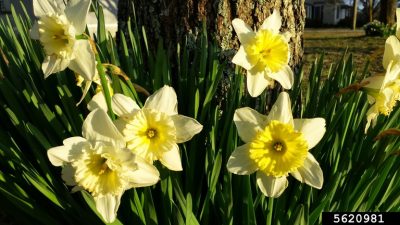By Abigayle Ward – Soil Science Graduate Student, UConn Department of Plant Science & Landscape Architecture

According to an ancient Greek myth, all those who had fallen in love with the young man Narcissus were met with contemptuous rejection. On a hunting trip, Narcissus stopped to drink from a pond and became enamored with his own reflection. Cursed to never experience a requited love of his own, he stared at himself until his death, and his place was taken by a flower.
While it remains disputed whether the character was named after the flower or vice versa, the enduring significance of the narcissus as a harbinger of spring is uncontested. With a native range spanning throughout most of Europe, northern Africa, and parts of Asia, legends describing this culturally significant early-season perennial have been told since antiquity. In China, daffodils are carefully grown to bloom for the Lunar New Year, which began this year on January 29th. Their Mandarin name, shuixianhua, literally translates as “immortal water flower”, attesting to their resilience throughout the early season cold.
The Royal Horticultural Society in the United Kingdom describes 13 different types of narcissi based primarily on morphological appearance and when they bloom. Some have long trumpets, while others have multiple flowers to one stem. Others have small trumpets and many petals, called ‘double daffodils’, while others still have few petals dwarfed by large, bowl-shaped trumpets. Daffodils also come in many interesting color combinations – while most of us are familiar with the classic yellow petals and orange trumpets, they also come with white petals, white trumpets, and some even have shades of salmon pink. As one of the earliest-blooming flowers in your garden, they add a lovely splash of color to an otherwise brown landscape. In beds, they go well with red or pink tulips. By themselves, daffodils make good borders, particularly if different color combinations are intermixed to create visual intrigue.
While it is too late now to plant daffodil bulbs with the guarantee of blooms, they can still be safely planted. If you have some bulbs and want to give them a try, be sure to plant them in a sunny spot with well-drained soil at least 6 to 8 inches below the surface. They may sprout, but not form a flower. Do not fear: Daffodils are quite resilient and will likely flower the next spring. If you want to wait, the ideal time to plant daffodils for blooms in the spring is November.
If you find an already-blooming daffodil at your local garden center, it can be planted in the ground any time after the blooms themselves have faded. Both the bulbs and the foliage are frost-hardy well into sub-zero temperatures, making them well-suited for growing in the unpredictable winter weather of Connecticut.
After the flowers have bloomed, you may wish to cut the flower stems and bring them indoors for some bright colors. If you leave the flowers on the plants, be sure to deadhead them as soon as the flowers begin to wilt. If daffodils are allowed to go to seed, the plant will divert precious nutrients and energy away from the bulb. Once the plant has finished flowering, only the foliage remains. While it is tempting to remove the foliage, the leaves are collecting energy and creating food for the bulb via photosynthesis. If the leaves are removed too early, the daffodil may not flower the following spring. Some gardeners like to tie up the leaves in rubber bands or braid them to keep them out of the way, although it is generally best practice to leave them alone until they turn brown by themselves. Damage to the leaves could introduce pathogens or attract pests, which could impact the ability of the plant to flower next year.
With proper care, daffodil bulbs can multiply, ensuring many blooms come back year after year. As we move forward into the season of renewal for ourselves and our gardens, consider planting some daffodils to add a bit of sunshine to your home landscape.
The UConn Home & Garden Education Center supports UConn Extension’s mission by providing answers you can trust with research-based information and resources. For questions about spring bulbs like daffodils or other gardening questions, contact us toll-free at (877) 486-6271, visit our website at homegarden.cahnr.uconn.edu, or reach out to your local UConn Extension center at cahnr.uconn.edu/extension/locations.
This article was published in the Hartford Courant Mar. 8 2025











